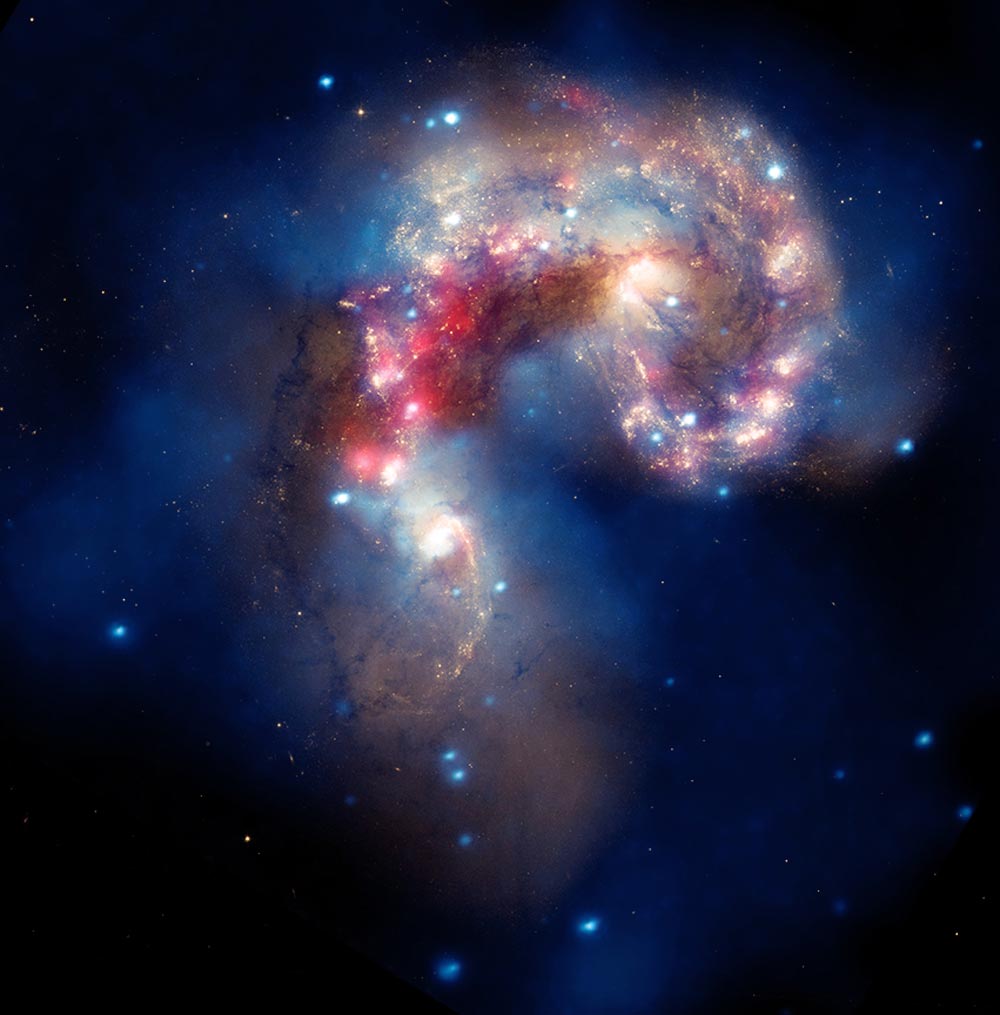Colliding Galaxies Swirl in Dazzling New Photo

Aspectacular new image of two colliding galaxies shows a cosmic region teemingwith stellar activity.
Thecosmic smash-up, which began more than 100 million years ago but is stilloccurring, has triggered the formation of millions of stars in the clouds ofdust and gas within the galaxies. The composite image was created using datafrom several different space telescopes. [Photo of the galactic spectacle.]
Themost massive of these young stars speed through their evolution in only a fewmillion years, dying a violent stellar death in supernovaexplosions.
Thecolliding Antennae galaxies are located about 62 million light-years away fromEarth. In addition to the photo, NASA also released a videoof the galaxy collision using the same data from the Chandra X-rayObservatory (blue), the Hubble Space Telescope (gold), and the Spitzer Space Telescope (red).
TheX-ray image from Chandra shows vast clouds of hot, interstellar gas that areinjected with rich deposits of elements, such as oxygen, iron, magnesium andsilicon, created in supernova explosions. The enriched gas will be incorporatedinto new generations of young stars and planets.
TheAntennae galaxies get their name from the long, wispy antenna-like"arms" that can be detected in wide-angle views of the system. Theseappendage features were produced by tidal forces that were generated from thecosmic collision.
Thebright, point-like sources in the image are produced by material that isfalling onto black holes and neutron stars, which are dead relics of massivestars. Some of the black holes in the Antennae galaxies may contain masses thatare almost one hundred times that of the sun.
Get the Space.com Newsletter
Breaking space news, the latest updates on rocket launches, skywatching events and more!
Thedata from the Spitzer telescope show infrared light from warm clouds of dustthat have been heated by newly-formed stars, with the brightest clouds lying inthe overlap region between the two colliding galaxies.
TheHubble data reveal old stars and star-forming regions in gold and white, whiledusty filaments appear in brown. In the optical image, many of the fainterobjects denote clusters containing thousands of stars.
TheChandra image was taken in Dec. 1999, the Spitzer image was taken in Dec. 2003,and the Hubble image was taken in July 2004 and Feb. 2005. Data from the threeobservatories were combined to make the new composite image, which was releasedThursday.
- Hubble Photos: When Galaxies Collide
- The Strangest Things in Space
- Top 10 Star Mysteries
Join our Space Forums to keep talking space on the latest missions, night sky and more! And if you have a news tip, correction or comment, let us know at: community@space.com.

Space.com is the premier source of space exploration, innovation and astronomy news, chronicling (and celebrating) humanity's ongoing expansion across the final frontier. Originally founded in 1999, Space.com is, and always has been, the passion of writers and editors who are space fans and also trained journalists. Our current news team consists of Editor-in-Chief Tariq Malik; Editor Hanneke Weitering, Senior Space Writer Mike Wall; Senior Writer Meghan Bartels; Senior Writer Chelsea Gohd, Senior Writer Tereza Pultarova and Staff Writer Alexander Cox, focusing on e-commerce. Senior Producer Steve Spaleta oversees our space videos, with Diana Whitcroft as our Social Media Editor.









